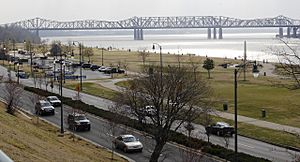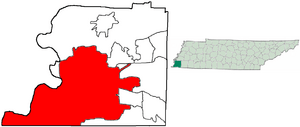Geography of Memphis, Tennessee facts for kids
The City of Memphis is a big city located on the eastern side of the Mississippi River in the southwest part of Tennessee. It's like a main center for a special area that includes parts of Arkansas, Mississippi, and Tennessee.
Memphis gets its water from four natural underground water sources called aquifers. One of these is known as the "Memphis sand aquifer." This amazing water source holds more than 100 trillion gallons of water!
The weather in Memphis is called a humid subtropical climate. This means it has four clear seasons. Summers are usually hot and humid because of moisture coming from the Gulf of Mexico.
Contents
Geography of Memphis
Memphis is located in the southwest part of Tennessee. The city sits right on the eastern bank of the Mississippi River. It's built on a spot called the 4th Chickasaw Bluff, which is just south of where the Wolf River flows into the Mississippi.
The city covers about 763.4 square kilometers (294.8 square miles). Most of this is land, but about 40.0 square kilometers (15.4 square miles) is water.
City Layout and Roads

Memphis is a central hub for the area where Arkansas, Mississippi, and Tennessee meet. The main part of the city is right on the Mississippi River, where the first settlements were built a long time ago.
Major highways like Interstate 40 and Interstate 55 help people travel in and out of Memphis. These roads connect to other highways like Interstate 240, which forms a loop around the central part of the city. There's also Interstate 269, which acts as an outer loop around Memphis.
Tallest Buildings in Memphis
Memphis has several tall buildings that stand out in its skyline. Here are some of the tallest:
| Name | Stories | Height |
|---|---|---|
| 100 North Main | 37 | 131 meters (430 feet) |
| Clark Tower Executive Suites | 32 | 122 meters (400 feet) |
| One Commerce Square | 31 | 121 meters (396 feet) |
| Sterick Building | 31 | 111 meters (365 feet) |
Memphis City Limits
Memphis has grown a lot over the years by adding nearby areas, a process called annexation. The city's western edge is the Mississippi River. To the north, it's bordered by rivers like the Loosahatchie River and nearby towns like Bartlett, Tennessee, Lakeland, Tennessee, and Arlington, Tennessee.
The eastern boundary follows the Wolf River and borders Germantown, Tennessee. To the south, the city limits are an uneven line that reaches the Mississippi State line.
Memphis Neighborhoods
Memphis has many different areas and neighborhoods. The city is generally divided into five main districts: Downtown, Midtown, North Memphis, South Memphis, and East Memphis. As the city has grown, these names might not always perfectly describe how far out these areas reach today.
Memphis Aquifer: Our Water Source
As mentioned before, Shelby County, where Memphis is located, has four natural aquifers. One of the most important is the "Memphis sand aquifer." This huge underground water source is found about 100 to 330 meters (350 to 1100 feet) below the ground. It holds more than 100 trillion gallons of water!
Memphis Light, Gas, and Water, the local utility company, gets water from this aquifer. They make sure it's clean and then send it to over 250,000 homes and businesses. Since people started using this water source in 1887, the water level has only dropped about 38 meters (125 feet). This shows that it's a very reliable source of water for many years to come.
People in Memphis are very proud of their aquifer and work hard to protect it from pollution. Memphis water is known for being very soft, meaning it has few minerals, and it's free of harmful substances.
Memphis Climate and Seasons
Memphis has a humid subtropical climate, which means it has hot, humid summers and mild winters. It experiences four distinct seasons.
Spring in Memphis
Spring usually starts in late February or early March. This season is sometimes called "severe weather season" because there can be more tornadoes, hail, and strong thunderstorms. Spring months tend to be the wettest, with more rainfall. The last freeze of spring usually happens around March 19.
Summer in Memphis
Summer in Memphis lasts from late May to late September. Temperatures are usually between 20 and 35 degrees Celsius (68 and 95 degrees Fahrenheit). It's also very humid because of moisture from the Gulf of Mexico. Afternoon thunderstorms can happen often in some summers, but they are usually short. On average, Memphis has about 70 days a year where the temperature reaches 32 degrees Celsius (90 degrees Fahrenheit) or higher. The hottest temperature ever recorded was 42 degrees Celsius (108 degrees Fahrenheit) on July 13, 1980.
Autumn in Memphis
In early autumn, the humidity starts to drop a little, but daytime temperatures stay warm until late October. Sometimes, there are sudden but short cold spells. Later in autumn, it gets rainier and colder. The leaves on trees become very colorful after the first frost, usually in November, and stay that way until early December.
Winter in Memphis
Winters in Memphis are generally mild. However, cold spells can happen. On average, there are about 47 days a year where the temperature drops to freezing or below. The coldest temperature ever recorded was -25 degrees Celsius (-13 degrees Fahrenheit) on December 24, 1963.
Snow doesn't fall a lot in Memphis, but it does happen most winters. The city gets about 9.7 centimeters (3.8 inches) of snow on average each winter. The most snow ever recorded in one day was 45.7 centimeters (18.0 inches) on March 17, 1892. Even though severe weather is more common in spring, tornadoes can sometimes happen in winter, like the one on February 5, 2008, which caused damage in Memphis.
Sister Cities of Memphis
Memphis has special connections with cities in other countries, called "sister cities." These connections help promote cultural understanding and exchanges.
 Kanifing, Gambia
Kanifing, Gambia Kaolack, Senegal
Kaolack, Senegal
Famous Landmarks in Memphis
Memphis is home to many important and interesting landmarks:
- Hernando de Soto Bridge (I-40) – A large bridge that crosses the Mississippi River.
- St. Jude Children's Research Hospital – A famous hospital dedicated to treating children with cancer and other serious diseases.
- 100 North Main Street – One of the tallest buildings in Memphis.
- Beale Street Visitors Center – The heart of Memphis's music scene, known for blues music.
- Sun Studio – A legendary recording studio where many famous musicians, like Elvis Presley, recorded their first songs.
- Lorraine Motel – A historic motel that is now the National Civil Rights Museum.
- National Ornamental Metal Museum – A museum dedicated to the art of metalworking.
- Graceland Mansion – The famous home of Elvis Presley, a very popular tourist attraction.
- Tennessee Brewery – A historic building that used to be a brewery.
- Memphis Pink Palace Museum – A museum with exhibits on natural and cultural history, plus a planetarium.


